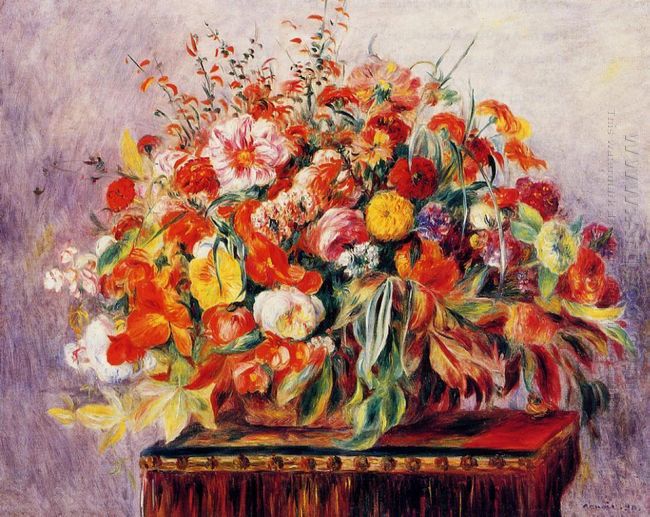 |
| Basket Of Flowers |
Subject
Flowers can be easily painted from imagination, from a photograph or from a live subject. Most people will find that working from a live subject will inform the painting in positive ways while adding a level of depth and complexity. If you wish to paint from imagination, it is helpful to observe and sketch live subjects before beginning your painting. Flowers are so present in our daily lives that they can become iconic when painted from imagination.
Medium
Watercolor, acrylic and oil paints may all yield significantly different results. Watercolors are transparent, luminous and whimsical, perfect for a painting of a flower. They are also difficult to control, so the painter should be relaxed about the results.
Acrylics are solid, bright and bold. They are quick drying and difficult to blend, but easy to paint over again and again. Painting a flower from acrylic will likely result in a vibrant (and maybe even edgy) image. Acrylics are permanent and non-fading.
Oil paints are similar to acrylic paints, but they are much more slow drying. The results may be slightly softer and less hard-edged, but otherwise similar to acrylic. Blending is easier for oil paints. Oil paints may yellow slightly with time, depending on the quality of the paint. This happens over a course of many, many years.
Painting
Break the flower down into its basic parts to begin. For example, if you are painting a sunflower, begin with the large circular center. Make the radiating petals, then the stem and leaves. Take the image one piece at a time.
You may choose to leave the background non-specific and relatively flat (painting only a few colors blended together, making the flower the obvious center of attention) or you may wish to paint a realistic background, such as a room or a garden.
If you are painting with acrylic or oil, you will want to begin by painting in thin washes and build color and paint in layers. If you are painting with watercolor, you will want to start off with lighter colors and build in layers (remember: watercolor cannot be erased and cannot be corrected very well once it is on the paper).
Finishing
You may wish to set your painting aside for a while and return to it with fresh eyes at a later time. Especially if you are working with oils, this will be important. Oil paints dry so slowly that once the canvas is saturated and wet, changes will be difficult to make until the paint has been given several hours or days to dry. You may wish to have someone else look at your painting before putting on the final touches. If you are painting this specifically to decorate a room, you may wish to put the painting on the wall to see if it looks right where you expect to hang it.
Once the painting is done, you may wish to have it professionally framed. Alternatively, if the painting is on a canvas, you can hang it without a frame. Paint the sides of the canvas to give it a finished look.
没有评论:
发表评论